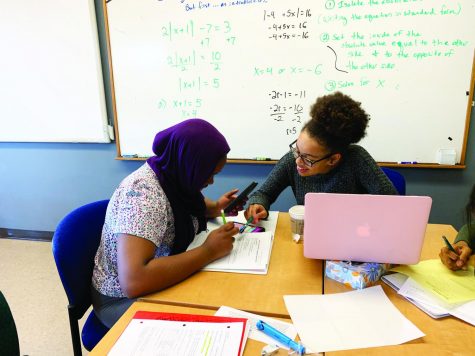Teachers Work to Find Teaching Moments in Instances of Academic Dishonesty
Consequences exist to help student learn from their mistake
November 8, 2019
When asked about what academic honesty means to her, math teacher Christin Winkler shares, “I think academic honesty is presenting something that reflects what you know without copying from someone else or receiving assistance from someone else.” This idea generally summarizes the role of academic honesty at Blake.
Pachao Yajcherthao, French teacher, sees academic dishonesty present itself predominantly in plagiarism and the excessive use of a translator, as well as students receiving help from tutors. In Yajcherthao’s class, the immediate consequence for a first-time offense is for her to talk to the student and the student has to redo the work, and that’s a warning…But I do have to let their dean know.

Stacy Helmbrecht-Wilson, a social studies teacher, says that when she finds someone is being academically dishonest, which in her classroom is likely cheating on a test or plagiarizing a written assignment, the consequences vary. “For cheating on formative assignments, I give a zero. For cheating on summative assignments, I usually allow a student to redo the assignment for either a 50% or a 60% grade, depending on what exactly happened with the academic dishonesty,” she explains.
Jen Vance, Freshmen Dean, sheds light on the process by saying that “There is an official communication from me to the child and the parents and 99% of the time it’s ‘this is what happened, here’s how we talk through it’ 100% of the time kids get why it’s problematic and also then [it’s] a warning in the sense of like ‘ok that’s your freebie’ the next one would have more academic consequences including potentially going to the CJB.” Vance also describes how when older students face run-ins with academic honesty issues, their dean will loop back to her to see whether or not it is a first-time offense.
Although to students it may seem that these are the only consequences of academic dishonesty, teachers find that there are more detrimental consequences that can affect students internally. For example, Winkler says, “From a human perspective, I know how crummy it feels when you cheat or steal or lie” and understand that these actions take a toll on the human psyche.
Additionally, Hembrecht-Wilson points out an aspect of academic dishonesty that creates issues for the students that do stick to academic honesty policies: “I think it also affects other students’ learning because when students are academically dishonest they’re artificially raising the bar in the classroom, and so other kids then become more stressed and have to work harder to do well which creates a much more stressful environment.”
Despite the fact that faculty members can clearly see the problems that arise from academic dishonesty, they try to make clear that mistakes like these are just that, mistakes, and they do not represent the student who makes them. Winkler says, “I like all of [my students] as people and so when I have to talk with them and sit down and say ‘look I have evidence that you cheated or plagiarized or did something that violates the academic honesty,’ I want to make sure they know I still like them. You made a mistake, [but] that doesn’t define you as a person, [and] I’m still here to support you 100%.”
This mindset stems from the fact that teachers understand the pressures that students face, and they understand that academic dishonesty often stems from these pressures being too much to handle. Vance feels that students may “lose sight of learning and really focus on that end grade or really focus on disappointing or not disappointing someone or the pressure to perform in a certain way, [and] that becomes in the forefront of their mind. I think [that] really prevents them from learning or getting the feedback in a way that can help them grow.”